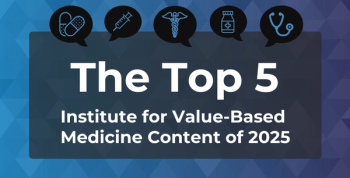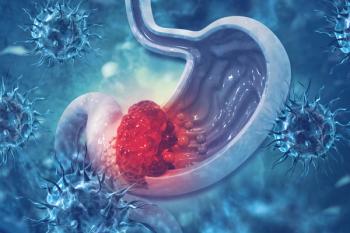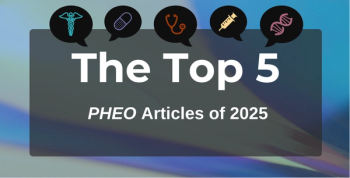
Nivolumab Continues to Produce Beneficial NSCLC Outcomes
This most recent analysis from the CheckMate 9LA trial provides 4-year follow-up data on patients with stage IV metastatic/recurrent non–small cell lung cancer (NSCLC) randomized to treatment with nivolumab plus ipilimumab and chemotherapy vs chemotherapy alone.
Tumor PD-L1 expression did not have an adverse impact on patient outcomes following treatment for stage IV metastatic/recurrent
This newest follow-up from CheckMate 9LA was published in
In CheckMate 9LA, patients were randomized 1:1 to 360 mg nivolumab every 3 weeks plus 1-mg/kg ipilimumab every 6 weeks and platinum-doublet chemotherapy every 3 weeks (n = 361) for 2 cycles or chemotherapy alone every 3 weeks for 4 cycles (n = 358). Sixty-eight percent had nonsuqamous NSCLC, the median follow-up was 54.4 (range, 49.1-64.4) months, and the minimum follow-up for overall survival (OS) was 47.9 months. In the study arm, treatment was given for a median 6.1 (range, 0-24.4) months; 93% received 2 chemotherapy cycles; patients had a median 9 (range, 1-36) and 4 (range, 1-18) nivolumab and ipilimumab doses, respectively; and 50% completed the 2-year treatment protocol. In the control arm, treatment was given for a median 2.5 (range, 0-58.2) months, patients had a median 4 cycles of chemotherapy, and 67% with nonsquamous NSCLC received pemetrexed maintenance. More patients overall in the control vs study arm required further systemic therapy (37% vs 49%) and received subsequent platinum-doublet chemotherapy (20% vs 6%), and fewer patients in the study group were administered additional immunotherapy 7% vs 36%).
“Although multiple phase 3 randomized trials of immunotherapy alone or in combination with chemotherapy have reported clinical survival outcomes at the 5-year milestone,” the authors wrote, “long-term survival in certain subpopulations, such as those with tumor programmed death ligand 1 (PD-L1) expression less than 1% or squamous histology, remains suboptimal.”
This newest follow-up shows a longer OS among those who received nivolumab plus ipilimumab and chemotherapy vs chemotherapy alone, at 15.8 (95% CI, 13.9-19.7) vs 11.0 (95% CI, 9.5-12.7) months, which translates to a 26% reduced risk of death (HR, 0.74; 95% CI, 0.63-0.87) and 4-year OS of 21% vs 16%. This outcome was seen no matter the PD-L1 expression (< 1%, > 1%, 1%-49%, > 50%) or histology.
In addition, an analysis that combined PD-L1 expression and histology produced similar results. For patients who had PD-L1 expression of less than 1% and squamous NSCLC, the treatment groups had a median OS of 15.3 (95% CI, 9.9-22.2) months compared with 8.0 (95% CI, 6.6-11.5) months in the chemotherapy-alone group, for a 50% reduced mortality risk (HR, 0.50; 95% CI, 0.30-0.83). Also, for patients with PD-L1 expression of less than 1% and nonsquamous NSCLC, the corresponding median OS were 18.6 (95% CI, 13.2-22.7) months and 12.4 (95% CI, 7.7-15.2) months, for a 27% reduced risk of death (HR, 0.73; 95% CI, 0.53-0.99).
Even further, PD-L1 expression of 1% or greater and squamous histology were linked to a 30% reduced risk of death (HR, 0.70; 95% CI, 0.49-0.99) and a 4-year OS of 19% in the combination treatment group vs 12% with chemotherapy alone, and PD-L1 expression of 1% or greater and nonsquamous histology were linked to a 23% reduced risk of death (HR, 0.77; 95% CI, 0.59-1.01) and a 4-year OS of 22% vs 18%, respectively.
These additional results were also seen in the nivolumab group vs chemotherapy alone:
- Progression-free survival of 12% vs 5%
- Overall response rate of 38% vs 25%, respectively
- Complete response rate of 4% vs 15
- Median duration of response of 12.4 vs 5.6 months
No new safety signals were seen, and among patients who discontinued the nivolumab combination because of treatment-related adverse effects, there was no negative impact on their clinical or efficacy benefit.
“In this 4-year update, patients treated with nivolumab plus ipilimumab with chemotherapy continued to have long-term, durable efficacy benefit over chemotherapy regardless of tumor PD-L1 expression and/or histology,” the study authors concluded. “A greater estimated relative OS benefit was observed after adjustment for subsequent immunotherapy use in the chemotherapy arm. These results further support nivolumab plus ipilimumab with chemotherapy as a first-line treatment for patients with metastatic/recurrent NSCLC, including those with tumor PD-L1<1% or squamous histology, populations with high unmet needs.”
Reference
Carbone DP, Ciuleanu TE, Schenker M, et al. Four-year clinical update and treatment switching-adjusted outcomes with first-line nivolumab plus ipilimumab with chemotherapy for metastatic non-small cell lung cancer in the CheckMate 9LA randomized trial. J Immunother Cancer. Published online February 12, 2024. doi:10.1136/jitc-2023-008189
Newsletter
Stay ahead of policy, cost, and value—subscribe to AJMC for expert insights at the intersection of clinical care and health economics.







































